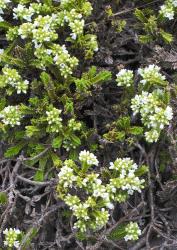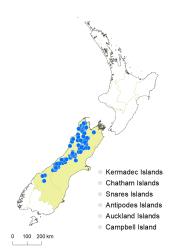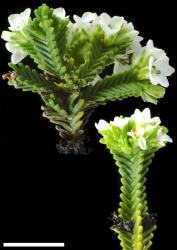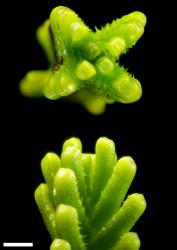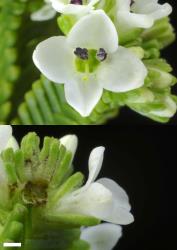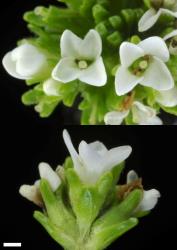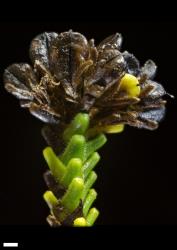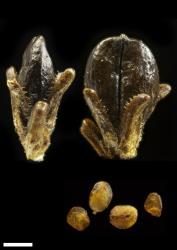- ≡ Mitrasacme hookeri Buchanan, Trans. & Proc. New Zealand Inst. 14: 348 (1882)
- = Logania ciliolata Hook.f., Handb. New Zealand Fl. 737 (1867)
- ≡ Veronica gilliesiana Kirk, Trans. New Zealand Inst. 28: 519 (1896) nom. nov. pro Logania ciliolata Hook.f. 1867
- ≡ Hebe ciliolata (Hook.f.) Cockayne & Allan, Trans. New Zealand Inst. 57: 39 (1926)
- ≡ Hebe gilliesiana (Kirk) J.T.Wall, New Fl. & Silva 11: 135 (1939)
- ≡ Leonohebe ciliolata (Hook.f.) Heads, Bot. Soc. Otago Newsl. 5: 5 (1987)
Semi-whipcord sub-shrub to 0.3 m tall. Stems decumbent, glabrous. Leaf bud indistinct, its outer leaves fully grown, diverging. Leaves opposite-decussate, connate in pairs and encircling stem, appressed to erecto-patent, crowded and overlapping; lamina sub-coriaceous, narrow-oblong above a broad, triangular base, 2–6 mm long, 1–3 mm wide, dull green to dark green above and beneath; veins not evident; surfaces glabrous; margin ciliate except at apex, entire; apex swollen and rounded; bases broad; petiole absent. Inflorescence a lateral spike or raceme, 4–10 mm long; flowers crowded, 2–6, female or male on separate plants, ♂ > ♀; bracts opposite-decussate, connate, deltoid, > pedicels; pedicels erecto-patent, 0–1 mm long, glabrous or eglandular-hairy all around. Calyx lobes 4, obtuse, equal, 2.0–2.5 mm long, mixed glandular- and eglandular-ciliate, rarely eglandular-hairy on outside. Corolla 3.0–6.5 mm diameter; tube white, 1.2–2.0 (♀) or 1.6–2.3 (♂) long, ≤calyx, glabrous; lobes 4, white, sub-erect to recurved, sub-equal to unequal, broadly ovate, rhomboid, or obovate, 1.2–2.5 mm long, obtuse; nectar guides absent. Stamen filaments white, 1.5–2.5 mm long (staminodes in ♀ 0.4–1.0 mm long); anthers magenta to purple. Style glabrous, 1.5–2.7 mm long. Capsules angustiseptate, obtuse, glabrous, 3.0–4.3 mm long, 1.6–3.3 mm at widest point. Seeds ellipsoid to discoid, flattened, smooth, brown, 0.8–1.3 mm long.
V. hookeri belongs to a well-supported clade of four species, the semi-whipcord hebes; the other species are V. quadrifaria, V. tetrasticha, and V. tumida. Semi-whipcord hebes are characterised by and distinguished from true whipcord hebes by very crowded, dull green, scale-like leaves that are long-persistent on old stems, dioecious sexual systems, and angustiseptate capsules.
The leaves of V. hookeri are longer than those seen in plants of the other three species, more-or-less oblong in shape above a broad base, with a blunt, swollen tip that usually has a small, sunken hydathode. The longer leaves mean that branchlet width including the leaves is 3–8 mm, whereas in the other semi-whipcord hebes leafy branchlets are 1.3–3.5(–4.0) mm wide.
South Island: Western Nelson, Sounds Nelson (Richmond Range), Westland, Marlborough (western), Canterbury (western). A single record from Otago, Mt Alta, the type specimen of Mitrasacme hookeri Buchanan, should be treated with caution as discussed by Bayly and Kellow (2006, as Leonohebe ciliolata).
Alpine rock outcrops and boulder-fields, often in exposed situations, in wetter mountain ranges mostly along and west of the main divide. Recorded elevations range from 793 to 2135 m.
V. hookeri appears to intergrade with V. tumida at some localities, possibly due to hybridism (Bayly & Kellow 2006).
There is also one record of V. hookeri × pulvinaris (Meudt & Bayly 2008).
Flowers: (October–)November–February(–July); fruits: January–March(–August).
2n = 42 (see Bayly & Kellow 2006, as Leonohebe ciliolata).
Veronica hookeri is classified in V. subg. Pseudoveronica sect. Hebe and informally in the “semi-whipcord hebe” group (Albach & Meudt 2010). V. hookeri belongs to a well-supported clade of four species, the semi-whipcord hebes; the other species are V. quadrifaria, V. tetrasticha, and V. tumida. Relationships within this grouping are unclear.



